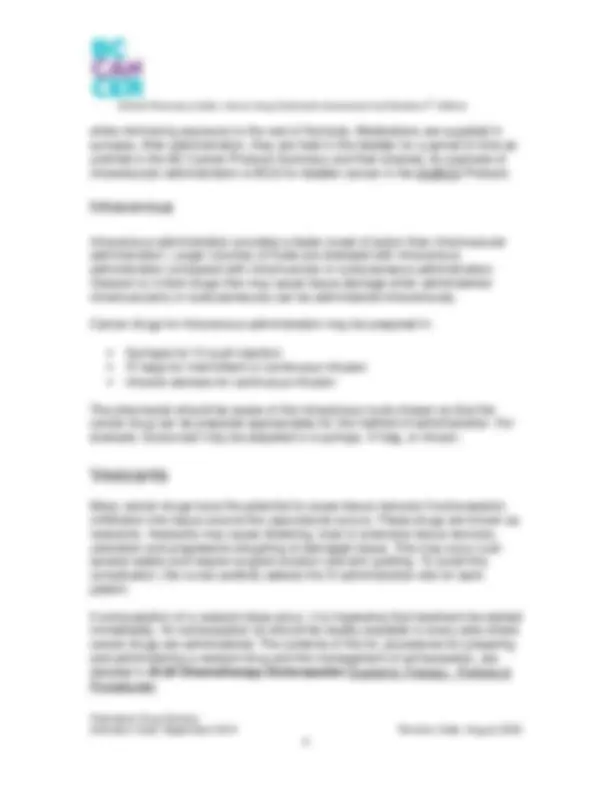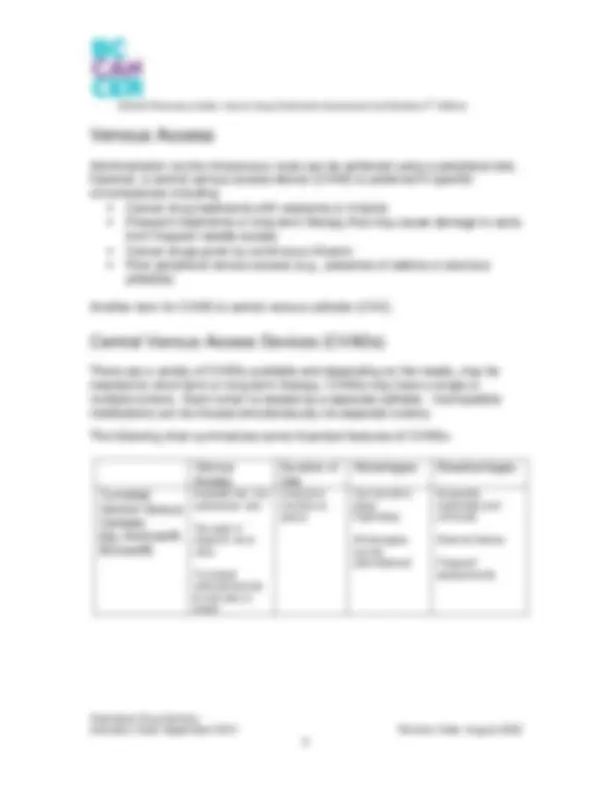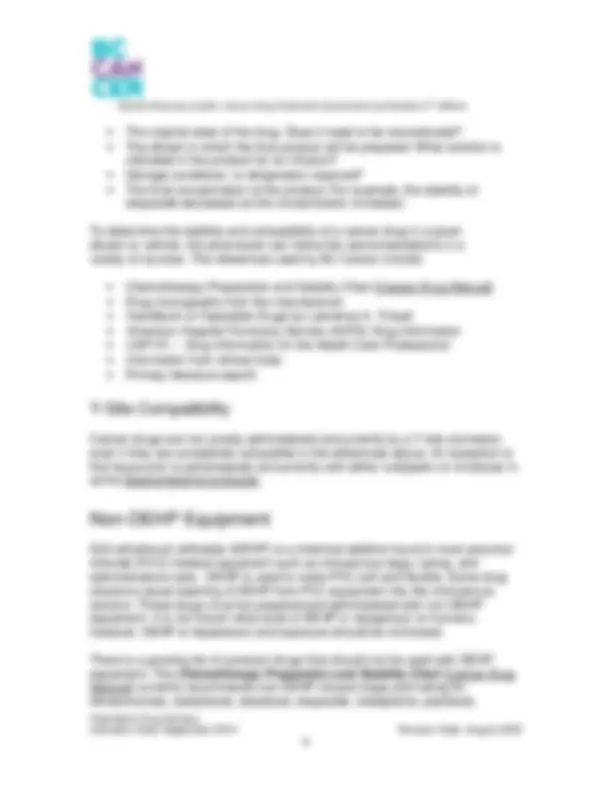







Study with the several resources on Docsity

Earn points by helping other students or get them with a premium plan


Prepare for your exams
Study with the several resources on Docsity

Earn points to download
Earn points by helping other students or get them with a premium plan
Community
Ask the community for help and clear up your study doubts
Discover the best universities in your country according to Docsity users
Free resources
Download our free guides on studying techniques, anxiety management strategies, and thesis advice from Docsity tutors
Guidelines for the administration of parenteral cancer medications, including routes of administration, precautions for specific drugs, and considerations for venous access. It emphasizes the importance of minimizing exposure to hazardous drugs and the use of closed systems for preparation and administration.
Typology: Study notes
1 / 9

This page cannot be seen from the preview
Don't miss anything!






Parenteral cancer medications, including hormonal therapy, are administered by several routes including:
Intravenous administration is the most frequently used route for parenteral cancer drug delivery.
At BC Cancer, most cancer drugs for parenteral administration are considered hazardous drugs, and are prepared and administered in a closed system using Closed System Drug Transfer Devices (CSDTDs) to minimize exposure to them (except when incompatible).
Because of the ease of administration, patients may be taught to self administer medications subcutaneously. Nursing practice varies by institution and may involve capping SC syringe volume at 2 to 2.5mL and more than one injection site may be required for larger volumes. However, this is not evidence based and certain drugs can be safely administered in larger volumes. For example, the rituximab monograph indicates that the rituximab SC 1400 mg dose can be administered as a single injection of 11.7 mL to one injection site. Refer to the applicable Chemotherapy Protocol, PPPO, and/or Cancer Drug Manual drug monograph to identify the tolerated subcutaneous injection volume for each drug where available.
The onset of action is faster with intramuscular administration than subcutaneous administration. Limited volumes of fluid are tolerated; more than one injection site may be required for larger volumes. For example, the Asparaginase monograph
Parenteral Drug Delivery Activation Date: September 2014 Revision Date: August 2020
while minimizing exposure to the rest of the body. Medications are supplied in syringes. After administration, they are held in the bladder for a period of time as outlined in the BC Cancer Protocol Summary and then drained. An example of intravesicular administration is BCG for bladder cancer in the GUBCG Protocol.
Intravenous administration provides a faster onset of action than intramuscular administration. Larger volumes of fluids are tolerated with intravenous administration compared with intramuscular or subcutaneous administration. Vesicant or irritant drugs that may cause tissue damage when administered intramuscularly or subcutaneously can be adminstered intravenously.
Cancer drugs for intravenous administration may be prepared in:
The pharmacist should be aware of the intravenous route chosen so that the cancer drug can be prepared appropriately for the method of administration. For example, fluorouracil may be prepared in a syringe, IV bag, or infusor.
Many cancer drugs have the potential to cause tissue necrosis if extravasation (infiltration into tissue around the vasculature) occurs. These drugs are known as vesicants. Vesicants may cause blistering, local or extensive tissue necrosis, ulceration and progressive sloughing of damaged tissue. This may occur over several weeks and require surgical excision and skin grafting. To avoid this complication, the nurse carefully selects the IV administration site for each patient.
If extravasation of a vesicant does occur, it is imperative that treatment be started immediately. An extravasation kit should be readily available in every area where cancer drugs are administered. The contents of the kit, procedures for preparing and administering a vesicant drug and the management of extravasation, are detailed in III-20 Chemotherapy Extravasation [Systemic Therapy - Policies & Procedures].
Parenteral Drug Delivery Activation Date: September 2014 Revision Date: August 2020
Administration via the intravenous route can be achieved using a peripheral site; however, a central venous access device (CVAD) is preferred in specific circumstances including:
Another term for CVAD is central venous catheter (CVC).
There are a variety of CVADs available and depending on the needs, may be inserted for short-term or long-term therapy. CVADs may have a single or multiple lumens. Each lumen is treated as a separate catheter. Incompatible medications can be infused simultaneously via separate lumens.
The following chart summarizes some important features of CVADs:
Venous Access
Duration of Use
Advantages Disadvantages
Tunneled Central Venous Catheter [eg.,Hickman®, Broviac®]
Inserted into the subclavian vein
Tip rests in superior vena cava
Tunneled subcutaneously to exit site on chest
Long-term (months to years)
Can be left in place indefinitely
All therapies can be administered
Surgically implanted and removed
External device
Frequent assessments
Parenteral Drug Delivery Activation Date: September 2014 Revision Date: August 2020
The infusion pumps used at BC Cancer are equipped with drug error reduction software (DERS) to minimize pump programming errors. The software provides a warning when dose, rate or concentration information is entered outside of the safe range for each medication in the drug library.
Some protocols require non-vesicant drugs to be delivered continuously, over an extended period of time. This can be accomplished using portable infusion devices. These devices provide flexibility to patients, allowing them to be ambulatory while receiving medication by a continuous, regulated infusion. They are generally small and inconspicuous, in order to minimize any impact on patients’ daily living activities. For example, an elastomeric infusion device is used in the GIFOLFIRI protocol in which fluorouracil (5-FU) is given intravenously by continuous infusion over 46 hours.
BC Cancer uses Baxter Infusors® (disposable elastomeric infusion devices) for all continuous infusions of 5-FU. These devices have elastomeric balloons that provide fixed infusion rates, so infusion rate programming is not required. This is one of the Institute for Safe Medication Practice (ISMP) recommendations to prevent pump infusion rate errors resulting from incorrect pump programming.
Please see Elastomeric Infusors for fluorouracil (5-FU) [Frequently Asked Questions - Cancer Drug Preparation and Administration] for more information about Baxter Infusors®, including checklists for rate error prevention, identifying the causes of rate errors, dose banding, and infusor selection.
It is the responsibility of the pharmacist to determine the stability and compatibility of the cancer drug prior to preparing the product for parenteral administration.
The stability of the drug being administered — specifically, the chemical stability of the cancer drug — can be affected by the following factors:
Parenteral Drug Delivery Activation Date: September 2014 Revision Date: August 2020
To determine the stability and compatibility of a cancer drug in a given diluent or vehicle, the pharmacist can follow the recommendations in a variety of sources. The references used by BC Cancer include:
Cancer drugs are not usually administered concurrently by a Y-site connector, even if they are considered compatible in the references above. An exception is that leucovorin is administered concurrently with either oxaliplatin or irinotecan in some Gastrointestinal protocols.
Di(2-ethylhexyl) phthalate (DEHP) is a chemical additive found in most polyvinyl chloride (PVC) medical equipment such as intravenous bags, tubing, and administrations sets. DEHP is used to make PVC soft and flexible. Some drug solutions cause leaching of DEHP from PVC equipment into the intravenous solution. These drugs must be prepared and administered with non-DEHP equipment. It is not known what level of DEHP is ‘dangerous’ to humans; however, DEHP is hepatotoxic and exposure should be minimized.
There is a growing list of cytotoxic drugs that should not be used with DEHP equipment. The Chemotherapy Preparation and Stability Chart [Cancer Drug Manual] currently recommends non-DEHP infusion bags and tubing for blinatumomab, cabazitaxel, docetaxel, etoposide, ixabepilone, paclitaxel,
Parenteral Drug Delivery Activation Date: September 2014 Revision Date: August 2020